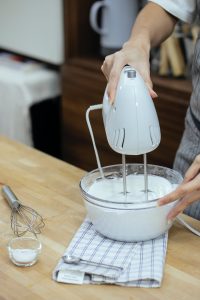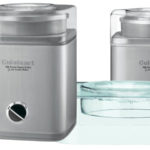Cuisinart ICE-30BC Ice Cream Maker Review - Based on all reviews and technical specifications Cuisinart…
Ice Cream Stabilizers — Your Questions Answered
The use of ice cream stabilizers has been a topic of heated debate among ice cream enthusiasts. Traditionalists think they’re unnatural, while science thinks they’re the answer ice cream makers have waited for.
If you’re a home ice cream maker who’s stuck on the fence about stabilizers, then this article will help you understand them better. Below, we answer essential questions about ice cream stabilizers and list those that are most commonly used.

What are ice cream stabilizers?
Ice cream stabilizers are defined as hydrocolloids. Or in simple terms, they are “thickeners”. When distributed to a liquid, stabilizers binds to water molecules which reduces their movement. Ultimately, this leads to thickening.
You can think of it as one of the basic things you do in cooking, adding flour to a sauce helps thicken the mixture.
Are they considered as a natural ingredient?
Stabilizers usually come from an animal, bacterial, or plant. Still, most countries consider them as food additives.
Why are stabilizers used in ice cream?
When making ice cream at home, it is often a challenge to achieve that restaurant-quality taste. The primary reason, in most cases, is because you’re missing their secret ingredient: stabilizers!
Stabilizers are used for more than just thickening an ice cream mixture. They also improve your ice cream in many ways:
- Increases Viscosity: As already established, the primary purpose of ice cream stabilizers is to increase thickness. This is also referred to as the mix viscosity.
- Increases Creaminess: The most critical textural characteristic of an ice cream is its creaminess. When an ice cream is made in an ice cream maker, ice crystals usually form. This leaves the ice cream with a coarse, grainy texture. When stabilizers are added while your ice cream is churning in your at-home ice cream maker, the result will be smooth, soft, and thick. High viscosity levels in your mixture will attribute to fewer ice crystals and more creaminess.
- Increases Melting Resistance: Stabilizers prevent your ice cream from melting too quickly. When making ice cream at home, you probably don’t have access to those high-end freezers that ice cream shops and restaurants use. Therefore, you will need all the help you can get to ensure that your ice cream retains its shape long after it’s been removed from the freezer and even when it starts to melt. If your mixture has high viscosity levels, the rate at which your ice cream will melt slows down significantly.
Why do some not want to use stabilizers?
Although stabilizers have benefits, many people are wary of using them, while some outright refuse. The main reasons for this are that people are unfamiliar with what they are or have had bad experiences with stabilizers. Home ice cream makers who prefer organic ingredients might be scared off because of their chemical appearances and strange names. Aside from those, people often also associate stabilizers with cheap ice creams where they were used to short cut the ice cream making process.

How much stabilizer should be used?
Overusing ice cream stabilizers will lead to a horrible mess! You will end up with a gummy ice cream that doesn’t melt quickly when eaten, resulting in a chewy texture. A pasty after-taste is also typical.
To avoid this, you need to ensure that you use the recommended 0.2-0.5% of stabilizer in your ice cream mix.
How should stabilizers be used?
When using stabilizers, there are three essential steps you need to follow: measuring, dispersing, and hydrating.
- Measuring: To measure your required amount of stabilizer, you need a high-quality kitchen scale that is preferably accurate to 0.01g to ensure that you don’t over-stabilize your mixture.
- Dispersing: The best way to distribute stabilizers when making ice cream at home is to add them to your dry ingredients. Only after it’s been mixed thoroughly should you add your liquid. Combining the stabilizer with your dry ingredients should take about 5 minutes to ensure that it is mixed properly.
- Hydrating: For a stabilizer to hydrate, it needs to absorb water, and each type of stabilizer does this differently. Check which type of stabilizer you are using as some require heat whilst others require cold water to hydrate. The hydrating time for each differs. To efficiently work with a stabilizer, you need to get the best hydrating from it.
What are the different types of ice cream stabilizers?
- Gels: Gel stabilizers have features of both liquids and solids. While gels are generally more challenging to work with, you can easily use a blender to break it up. If you’re making a low-fat version, gel stabilizers will add a creamy texture and some fluff.
- Gums: Thanks to their unique chemical structures, gels are often described as the most flexible, powerful, and helpful type of stabilizer. Gums come as an off-white powder and are so powerful that you only need about 0.1-0.5% of your base mix. While they’re powerful when used alone, combining different gums will lead to new effects. When you’re making ice cream at home, you have the freedom to experiment, and gums are perfect for doing that!
What different gum stabilizers can you get?
Most gums used in ice cream making are natural. Here’s a list of a few:
- Cellulose Gum
- Guar Gum
- Gelatin
- Locust Bean Gum
- Pectin
- Seawood Gum
- Xanthan Gum

To Sum It Up
When you’re making ice cream at home, it can be tricky to get that desired thick, soft, creamy, yet fluffy texture. Stabilizers can help you get the right consistency, fluff, plus a smooth and superior finish. Once scooped, you can experiment with fun serving styles since your ice cream creation won’t melt as fast either.
When used in the right quantity and dispersed and hydrated correctly, stabilizers are supposed to work perfectly fine. Stabilizers are natural, safe to use, and can help you make better ice cream. If you want to produce ice cream that will make professionals stand back, experimenting with ice cream stabilizers should be on your to-do list!
Join Me In The Fun of Making Ice Cream at Home!
Hi, my name is Simone and I LOVE making and eating ice cream. I have searched long and hard to find the best ice cream maker reviews and tips on the best ice cream makers.
Find out a little more about myself and the IceCream Maker Guru gang here.
Thanks for visiting and may your ice cream always be delicious!
Simone xx
Categories
Recent Posts
Most Popular Posts
Share with Friends
Related Posts
-
Cuisinart ICE-30BC Ice Cream Maker Review
-
Best Ice Cream Scoop for Hard Ice Cream
Best Ice Cream Scoop 2020 is here! Looking for the Best Ice Cream Scoop for…
-
Cuisinart Ice Cream Maker Comparison – Find the Best Cuisinart Ice Cream Maker for You
Money can never go wrong when you want to invest in a Cuisinart ice cream…







